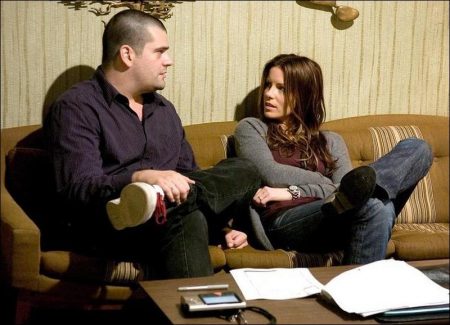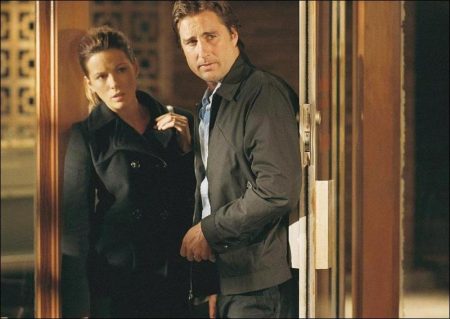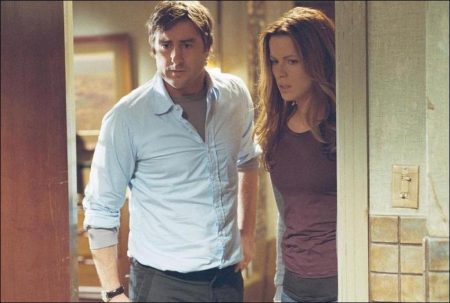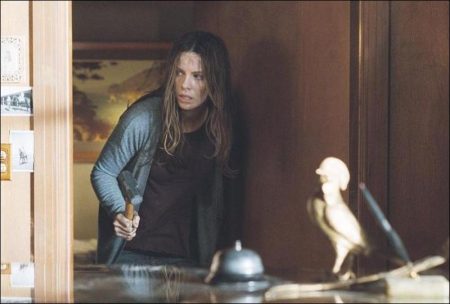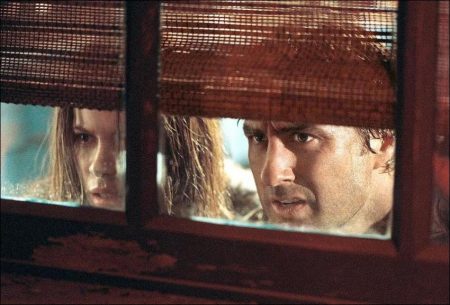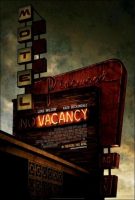Taglines: Once you’ve checked in… The terror begins.
A late night detour leads to an unimaginable nightmare when an estranged couple’s car breaks down on a remote country road. Finding themselves stranded on a dark and deserted two-lane highway, David Fox (Luke Wilson) and his soon-to-be ex-wife Amy (Kate Beckinsale) are forced to spend the night at a seedy motel run by an odd but seemingly harmless proprietor (Frank Whaley).
In their filthy, threadbare room, the bickering couple finds a cache of homemade slasher films that look disturbingly real. Once they realize the blood-soaked videos were shot in the very room in which they’re staying, David and Amy know they will be the sadistic filmmakers’ next victims unless they put aside their differences and work together to escape.
After the accidental death of their young son, Amy (Kate Beckinsale) and David’s (Luke Wilson) marriage is in tatters. Returning from their last trip together before finalizing their divorce, David decides to take an unfamiliar short cut down a desolate back road. When their car breaks down they find they have no choice but to stay at a nearby motel where the distracted night manager, Mason (Frank Whaley), seems more interested in watching lurid horror films than helping them with their engine troubles.
The couple resign themselves to a tense and uncomfortable night together in the rundown room, but no sooner do they turn down the ratty bed covers than they begin to hear frantic banging from the room next door. When they complain about the noise, Mason informs the Foxes they are the motels only guests, and suggests a vagrant may have broken in and taken up temporary residence next door.
Jittery and desperate to unwind, David tries watching some unmarked videos he finds in the room which turn out to be graphic, low-budget slasher films. After a few minutes, David realizes with growing horror that the brutal violence in the videos isn’t make-believe. Fitted with multiple hidden cameras, the motels “honeymoon suite” is the arena for a sickening and deadly game of cat and mouse.
The couple soon figures out that the bloodthirsty killers intend to make David and Amy the stars of their next snuff film. As they begin their frantic effort to escape, they find their captors are filming their every move, toying with them to increase the sadistic appeal of the production. With their tormentors closing in fast, David and Amy must learn to depend on each other again if they are to have any chance of surviving the longest night of their lives.
A deft blend of blood-curdling horror film and taut psychological thriller, VACANCY transcends both genres with its compelling storyline of loss, love and redemption.
The Making of Vacancy
“I can give you two the honeymoon suite for five dollars extra. Got a few perks that the others don’t.” – MASON
The concept for VACANCY had been percolating in the imagination of writer Mark L. Smith for almost eight years before it found its way to the big screen. While driving the back roads of New Mexico with his wife, Smith noticed a number of small, roadside motels that seemed to exist without any guests. “I wondered how they stayed open, where else they got their money,” recalls Smith. “The idea just kind of stayed with me.”
Smith knew that the key to making his story both terrifying and compelling was to create characters audiences would relate to. Taking a cue from master of suspense Alfred Hitchcock, Smith realized taking the time to introduce David and Amy Fox and the nature of their fragile relationship early in the film would pay off later, upping the film’s nail-biting suspense.
“The first twenty minutes, nothing terrible happens, but you get to know the characters and care about them,” he says. “You feel like, if it wasn’t them, it could be us. It could be my wife and me – or anyone.”
Smith brought the script to Brian Paschal, director of development at the Sony Pictures-based Hal Lieberman Company. “I was hooked as soon as I heard the log line,” remembers Paschal, who served as executive producer on the film. “It’s one of those scripts where you don’t notice that you’re turning the pages, and then you look up and you’re finished. The film is dark and twisted and the snuff films are creepy, but the story is really about this couple finding the will to live and the desire to be with one another.”
“Sometimes in thrillers or horror movies, you find yourself looking at the screen saying, why don’t they just kill them?” Paschal continues. “What I love about this film is that it answers that. The killers are making a movie. And the more they toy with David and Amy, the more that they elicit fear out of these people, the better the movie will be.”
Paschal brought the script to Hal Lieberman, who immediately signed on as the film’s producer. “Mark is a fine writer; somebody we had wanted to work with,” says Lieberman. “VACANCY is very high concept, very powerful. It never lets up. From the very moment they check in to the motel to the last frame of the film, it’s a hellacious chase, and watching them get through it is exciting.”
The former Universal Pictures production president likens the experience to a theme park thrill ride. “Why do people go on roller coasters? They go to be thrilled and to be scared, but they know that when the ride is over that they’ll be fine. With this movie, they can put themselves in the place of the lead characters and ask themselves, if that happened to me, would I get out alive?”
Lieberman sent the screenplay to Clint Culpepper, president of Screen Gems, the Sony Pictures specialty division which has had success with such recent horror titles as “The Exorcism of Emily Rose” and “When a Stranger Calls”.
“Clint read it on a Saturday,” recalls the producer. “He called me thirty pages into the script and said, ‘Oh, my God, this is scaring me to death. Let me call you back when I’m done reading it.’ He finished it, fell in love with it and bought the script that weekend.”
With the deal in place, the producers began searching for a director who could bring Smith’s script to life on the screen. Lieberman suggested Nimrod Antal, a young American who had recently completed his first feature, “Kontroll”, in Hungary. An intense drama set almost entirely in the Budapest subway system, “Kontroll” had earned the Prix de la Jeunesse at the 2004 Cannes Film Festival and created enormous buzz for the young filmmaker at festivals throughout Europe and the U.S.
“Kontroll was brilliant and extraordinarily well crafted,” says Lieberman. “It showed Nimrod not only knew what he was doing with the camera, but that he could sustain a unique and entertaining tone in a constricted environment. His take on VACANCY was to tell a story about two people and to make it real and make it powerful.”
“We should’ve stayed on the Interstate.” – DAVID
For the roles of David and Amy Fox, the filmmakers knew they had to find innately appealing actors who possessed the stamina required for the physically challenging roles as well as the acting talent to sustain the high level of emotional intensity required.
Kate Beckinsale has starred in films that range from acclaimed indie hits including “Laurel Canyon” and “The Golden Bowl” to big budget blockbusters such as “The Aviator” and “Pearl Harbor”. Meanwhile, her role as the powerful vampire Selene in the “Underworld” franchise has made her one of the leading female action stars in Hollywood.
Beckinsale says she was drawn to the role of Amy Fox in VACANCY by the complex relationship at the heart of the story. “It seemed fresh to me to start a movie in a marriage that’s going really badly and then throw in a bunch of different circumstances that really test the relationship,” says Beckinsale. “Once the stakes get raised to the point where it’s life and death, you’re left with just that one question of ‘Do I care about this person or not?’ It’s not that often in life you have to ask yourself such a stripped-down question.”
Even with extensive experience in action films behind her, Beckinsale wasn’t fully prepared for the unique challenges VACANCY presented. “I’ve had more physically demanding roles, but I got more bruises on this movie than I’ve had on any other movie. It’s very tiring for an actor actually to be spending so much time terrified. If you’re going be authentic, it’s such a heightened state-of-being to be in that much fear.”
Antal says he was blown away by Beckinsale’s talent, professionalism and dedication to her craft. “She was always so well-prepared. She would show up and she would hit it in two takes. Just trying to get yourself in that mindset of being scared day in and day out I think was an incredibly difficult challenge, and she just nailed it. I mean, she was really, really incredible.”
His role as David Fox in VACANCY posed a new kind of challenge for Luke Wilson, who is best known for his work in hit comedies such as “Old School” and “Legally Blonde”. “His performance is going to surprise a lot of people, I think, because they’re not accustomed to seeing him in these kinds of roles,” says Antal.
Wilson says he was attracted to the role of an ordinary guy who finds himself caught in an extraordinary circumstance. “My character’s not like MacGyver or some Harrison Ford action star,” he says. “He’s just trying to keep his wife alive, trying to keep himself alive by sheer instinct. But as the night progresses, you feel our chances slipping away. So it gets more and more terrifying.”
Like Beckinsale, Wilson says the film was among the most physically taxing he’s been involved in. “When we actually began shooting, I thought, ‘Gosh, I have forty or fifty days of doing this all day long.’ I was more tired than I’ve been on other movies.
But, it was really satisfying. I’m not complaining that it’s like working in a coal mine, but I actually felt like I was working hard. Kate was really good at getting up for scenes and keeping the intensity going. It inspired me to try and do the same.”
Producer Lieberman describes Wilson’s character as “a guy trying to figure out a way to bring back his wife. He does it dryly and with some sarcasm, but that’s just a mechanism to try to reconnect. Things often work because there’s chemistry within a couple. And I think the movie shows that these two have a lot of chemistry.”
Although Wilson didn’t know Antal before he started work on the film, actor and director quickly forged a close working relationship. “Every director has their style and way of talking to you,” says Wilson. “With Nimrod, it’s more of a partnership and a friendship, and we have a real rapport. He was very helpful in terms of the arc of the movie.”
Filming VACANCY’s action scenes was also a new experience for Wilson. “It gave me a new appreciation for the guys who do action and are really great at it. At first I didn’t feel that comfortable doing those scenes, because it felt foreign to most of the movies I do. But as we got further into it I was able to of relax more and have more fun with it.”
The third major piece of the casting puzzle was the character of Mason, the sadistic hotel manager and criminal mastermind. The filmmakers knew finding the right actor for the role would be crucial to making the story work. “The film could have lost its energy if we didn’t have someone who is believable but at the same time brings something quirky to the role,” says Antal. “The thing about Mason is that he doesn’t appear extraordinary when you first meet him. He seems maybe a little bit odd, but not too terribly odd.”
The filmmakers found their Mason in Frank Whaley, an actor whose work Antal had admired since the early ‘90s when he appeared as a baby-faced hitman in “Hoffa” and a deranged assistant in “Swmming with Sharks”. “He just played the villain so well in each one,” says the director. “Frank was a gift to our film.
Whaley and Antal put a lot of thought and energy into fine tuning Mason’s character. “We decided he would just be outward and jovial, and not very creepy, not to tip the hand too early and keep it suspenseful,” says the actor. “So in the beginning he has this very welcoming manner, but it’s just slightly off. David and Amy just think he’s this oddball character. They have no idea what they’re in for. ”
The pivotal role of The Mechanic has dialogue in only one scene, but the character sets the entire nightmare scenario in motion. It required an actor who could win the audience’s trust, while giving them just a whiff of the danger ahead. Ethan Embry, who has been performing since he was a child, had exactly the charm and intensity the filmmakers were looking for.
“He’s very charismatic,” says Paschal. “We needed that, because there’s a little flirtation between him and Kate. It was important that it not be clear if he is involved. There’s always the chance that maybe he’s coming back in the morning and will save them.”
* * *
“Gets a little boring around here late nights.” – MASON
More than just its central location, the Pinewood Motel serves as a major character in VACANCY. The filmmakers had a clear idea of what they wanted it to look like, but finding the perfect dilapidated motel proved difficult, especially one in a rural, wooded environment. After scouting locations throughout southern California, they hit on a unique solution.
“We decided the best thing to do, if we could, was to actually build the motel to meet our exact specifications,” says producer Lieberman. “The people at Sony were nice enough to give us Stage 15, which is one of the largest soundstages in the world, and let us build the entire motel and the gas station on it.”
Antal quickly embraced the advantages of shooting most of VACANCY on the soundstage where such landmark films as “The Wizard of Oz” and “Spider-man” were filmed. “We could shoot in the day. We weren’t limited by sunlight. We weren’t limited by weather. We had complete control of what every nook and cranny looked like. I remember the first day stepping on the soundstage with nothing there, and just being overwhelmed by the sheer size. And then I remember going back and seeing the set for the first time. For someone in my shoes, it was the biggest toy store in the world.”
Production designer Jon Gary Steele’s team built not one, but two versions of the Pinewood Motel. While interiors and some exteriors were shot on the historic 42,000 square foot soundstage, nighttime exterior shots were filmed at a second set on the Disney Ranch in Placerito Canyon. The two sets were identical, right down to the last branch on an eight-ton oak tree.
“We had to duplicate the tree we used at the Disney Ranch, so we found a black oak in Big Bear that matched the one on the Placerito Canyon set. Because it was damaged, we were allowed to chop it down. It took at 75-foot crane to drop it onto the Sony stage. Branches made from real elm branches and pipes were placed into it to make it as full as the one at the ranch.”
Steele knew exactly what the filmmakers were looking for in terms of the Pinewood Motel’s interior details. “We’ve all gone to this motel,” he says. “But this one is a little nastier than the ones everyone knows. And that’s the whole idea – it’s supposed to be a real rundown place. Everything was aged down a notch. We took wallpaper and glazed it to make it look older, and then we ‘nicotined’ it and beat up the furniture a bit more.”
To increase the sense of claustrophobia and entrapment, the motel was constructed in a U-shape, making it possible for just two people to keep Amy and David from escaping. “It’s like the old Route 66 motels that have the porticoes you drive under where the family sat in the car while dad went to register and get the key,” observes Steele. “It’s a nice slice of Americana from back in the late ‘60s or early ‘70s.”
“I think that the geography of the motel will hold a lot of surprises for the viewers,” says director Antal. “You think you’re limited to one room, but you’re not. And, the motel and the gas station have a lot of nooks and crannies that our heroes discover as they attempt to escape.”
The cast members were duly impressed with Steele and his team’s work. “It was the coolest set I’ve ever been on,” declares Wilson. “They had the entire motel built, including the rooms and the entire gas station and a huge tree. It was definitely a set where I was calling friends saying, hey, you should come visit me at work.”
Beckinsale describes the set as walking into another world. “Stage 15 is enormous and it seemed like trees were growing there, and this enormous, very detailed hotel, and gas station,” she says.
Whaley, whose character lives at the motel and has turned it into a deadly trap for unsuspecting travelers, marveled over the level of detail involved. “Every last thing, matchbooks and doorknobs and the sink in the back that’s full of dishes. It’s a real motel stuck in time.”
Virtually all of the film’s action takes place in the narrow confines of the Pinewood’s rooms and courtyard parking lot. Those restrictions could limit a filmmaker’s choices in terms of camera placement, but Steele and his team constructed the motel so that every wall and ceiling could be removed, allowing them to shoot interiors from any angle.
Steele notes that the set’s design also contributed to the terrifyingly claustrophobic atmosphere of the film. “For instance, we used a lot of glass in the gas station which creates a bird-in-a-cage feeling,” he adds. “There is one scene when they come up from one of the tunnels and realize they are still trapped.”
When Steele and his team examined the blueprints for the sound stage, they discovered it had a pit which they were able to dig into to create the motel’s underground tunnels. “The tunnels were very important to the set because the killers needed a way to get from one room to another without being seen,” he says. “They also used the tunnels to remove the bodies from the room and stash them underneath the hotel. So we created this multi-purpose tunnel system under the sound stage.”
Interestingly, the tunnels actually weren’t in Smith’s original draft of the script. “Because the characters were spending a lot of time in one room, we were trying to think of some way to get them out,” says the screenwriter. “Brian said to me, ‘What if there are tunnels?’ Once he gave me the idea, then it was like, oh, man, this is a whole new world to play with.”
The idea of spending so much time shooting underground initially concerned Beckinsale. “I’m quite claustrophobic. I thought maybe I’d feel very freaked out, but actually it was a huge anticlimax when I got in there. The tunnels were lit, and I could always see an exit. It was so cozy in there, my daughter came in one day and had loads of fun crawling around inside.”
“The tunnels were almost fun,” says Wilson. “It helped to have Kate in there with me. It wasn’t as enjoyable with the rats. That was a bit gnarly, but we managed to get through it.”
The rat scene didn’t bother Beckinsale, however, who says she was expecting to be sharing the screen with more aggressive big city rodents. “The rats were very pleasant movie rats. It was like spending the day with a hundred Stuart Littles. They do poop, and did in my hair a couple times, but they were clean, cute little rascals, so it was okay. I thought of them as friends – several hundred friends.”
***
We’ve got to find another way out. – DAVID
Director of photography Andrzej Sekula, who shot Quentin Taratino’s “Resevoir Dogs” and “Pulp Fiction”, says the fact that Antal had training as a cinematographer made it easier for them to collaborate to produce VACANCY’s dark, edgy visuals. Sekula and Antal agreed that a high contrast look would enhance the sense of uncertainty and fear the characters experience. “The light is not gimmicky or pretty. It’s not like reflected light or diffused light. But it allowed me to create patches of light on which you suddenly spot the killers. Very often, characters go from light to shadow and back to light.”
While creating the sharp contrast and deep shadows that give the film its eerie sense of unease, Sekula tried to leave as much room for flexibility and last-minute improvisation as possible. “You design the shot, but you give yourself a really huge margin,” he says. “There are so many elements on the set that can change things, like when the actors want to move, weather or technical problems. So you can’t really decide what light is best until you have the camera and you frame the shot.”
Since most of the action takes place in the close quarters of the small motel room and the Prairie View’s network of underground tunnels, camera movement became very important in sustaining mood and pace. That included the use of both Steadicam and handheld cameras. “When you’re shooting in small, confined places, you try to make the image as dynamic and attractive as possible,” says Sekula. “You change the camera position to keep the viewers’ attention.”
Sekula also created VACANCY’s shocking snuff film sequences. Using simple logic, he placed seven hidden cameras throughout the Foxes motel room. “We put the cameras where we could see the most people, almost like in a department store surveillance camera. We just tried to cover every possible angle.” To add authenticity to the snuff films’ look, the filmmakers captured footage on high quality tape, edited it and then degraded the quality to make it look like it was captured on VHS.
While VACANCY’s unique brand of terror emphasizes characters and psychology over action and gore, the film is punctuated by a few memorable stunts including an intense car crash sequence in which one of the killers is pinned to a motel room wall. Expert stunt coordinator Lance Gilbert came up with an ingenious plan that allowed the crash to be filmed live rather than through computer graphics.
They did this by using new technology that involves a system of cables and computerized winches. “Winches were used in theaters years ago to move curtains and stuff like that. These particular winches work with software that you can program to within a tenth of an inch. The beauty of being able to do it for real and live is that the actors get the feeling of what it feels like to have a car really coming at you.”
While numerous safety precautions were of course taken on the set, says director Antal, “You’re not going to see that on film. It’s terrifying. The car and the camera were rigged up to a pulley system. We basically blocked out the movement at half speed with our cameraman composing appropriately. And, with a push of a button, the rig is synced up and it did the shot for us. It was a little bit scary seeing that machine taking over and making a film. But it was also pretty incredible.”
The stunt crew warned Beckinsale that the crash was going to be terrifyingly real. “They told me to be prepared, so I got myself really panicked. I thought it’s probably going to be the most frightening thing I’ve ever done. It was actually perfectly fine. I can’t speak for the guy who was hit by the car, of course.”
For writer Mark L. Smith, the ultimate payoff will be seeing VACANCY in a regular theater with an audience of strangers. “I want to experience it for the first time with them,” he says. “With thrillers, or anything scary, so much of the fun is the reactions you get from the people around you.”
Beckinsale admits that she enjoys a good scare herself and hopes audiences will be interested in the same qualities in the film that appealed to her. “The most important thing is that people invest in these characters. It’s a complicated and interesting relationship, in addition to being entertaining and scary and heartwarming.”
Whaley observes that very real possibilities explored in the story will cater to the darkest part of viewers’ imaginations. “People get lost all the time and we never know what happened to them. You could drive into a motel like this at the side of the road, they’re all over. And you might never come out.”
Vacancy (2007)
Directed by: Nimrod Antal
Starring: Kate Beckinsale, Luke Wilson, Frank Whaley, Ethan Embry, Scott G. Anderson, Mark Casella, David Doty, Meegan Godfrey, Kym Stys, Caryn Mower, Dale Waddington
Screenplay by: Mark L. Smith
Production Design by: Jon Gary Steele
Cinematography by: Andrzej Sekula
Film Editing by: Armen Minasian
Costume Design by: Maya Lieberman
Set Decoration by: Traci Kirshbaum
Art Direction by: Chris Cornwell
Music by: Paul Haslinger
MPAA Rating: R for brutal violence and terror, brief nudity and language.
Distributed by: Sony ScreenGems
Release Date: April 20, 2007
Visits: 88
